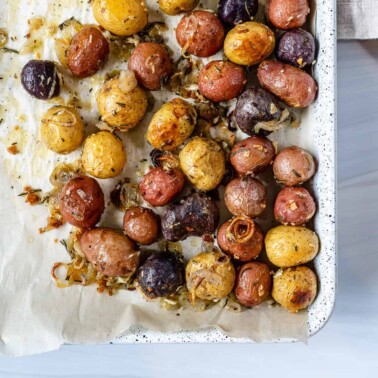As an Amazon Associate I earn from qualifying purchases.
Let’s talk kale! This mighty deep green leafy vegetable is delicious, a nutritional powerhouse and we think you should try to add it to your dishes as much as possible. On soups, stews, curries, salads, or smoothies, kale will elevate your meal and take it from healthy to extra-healthy. If you’re a bit spooked by the color and its broccoli-like taste, we hope this guide helps you overcome those fears and surrender to the amazing world of kale possibilities with this Kale Guide.
What is Kale?
Kale is a leafy green vegetable, related to broccoli and mustard (yes you heard that right!), it is a member of the Brassicaceae or cruciferous family (which has some pretty renowned members like cabbage, cauliflower, and radish). It is a pretty hardy vegetable and some varieties thrive in cold climates while others in warmer zones.
It has a milder broccoli taste and a very firm texture, depending on its variety.
A Guide to Different Types of Kale
- Common Curly Kale: This is the one we see most often at grocery stores or farmers’ markets. It’s voluminous, chewy, and curly with a thick and hard stem, it’s great for soups and stews. If you like to eat it in salads we recommend massaging it for a softer texture.
- Lacinato Kale (or also called Dinosaur Kale, Cavolo Nero, or Tuscan Kale): This darker green (almost black) variety grows in warmer climates and has a much softer texture. We love using this one on stir-fries and veggie pasta dishes.
- Red Russian Kale: This type of kale is very resistant to frost (actually thrives in it!) and tastes better after longer cooking times. Also great for soups and hearty dishes, and has an intense blue-green color to it. Great for eating raw in salads too!
- Siberian Kale: This kale grows much larger than all the rest but has the common love for chilly weather. It is sweeter than its relatives and the capacity to become more tender.
- Redbor Kale: This gorgeous intense purple variety looks great in your garden as well as in your meals. It’s milder in flavor than the others.
Is Kale Really That Nutritious?
In one word, YES! Kale does live to its hype and it is not another one of the latest nutritional fads out there. It is packed with amazing and vital nutrients, which make it a real favorite when trying to eat healthier. It’s one of those foods which pack a punch (a nutritional punch that is!) without much of an effort. Should we look at the details on the magic of kale?
- There are many healthy foods out there, but kale wins the race when it comes to the most nutritionally dense.
It contains large amounts of the key vitamins, like A, K, C, B6, and other vital nutrients like Manganese, Calcium, Copper, - Potassium and Magnesium.
- It’s high in antioxidants like Kaempferol and Quercetin.
- It has the ability to overall provide you with many nutrients which are vital to avoid major diseases (like heart issues, cancer, and eye problems).
How to Cut it and Cook it?
Cutting Kale:
By Knife: When it comes to cutting kale, you’ll need a good and sharp knife. Make sure you remove the stems as they are very fibrous and almost inedible. Depending on the preparation you plan to use it in, chop it like any other leafy green, although it will take more of an effort to chop since the texture is harder.
Removing the Stem: As we mentioned before, kale stems are not really edible so it’s best to remove them. One cool trick you can use is to hold the stem in one hand and strip leaves along the stem away from you.
No Need to Fancy Chop for Smoothies: If you’re planning on using your kale for smoothies, you can just destem and throw it in there. No fine chopping needed.
Cooking Kale:
Raw: If you’re a fan of green salads, some chopped kale would be a great addition. It’s chewier than lettuce or spinach but that gives the salad more volume and texture. If you’d like to soften it up a bit, we recommend massaging it with some olive oil before.
Steamed: Another great way to enjoy kale is steaming it. It will become tender and seriously delicious with some drizzled olive oil or tahini and some sea salt.
Sauteed: This one is another favorite way to eat this mighty green. Sauteing it with some minced garlic and oil in the pan might become your go-to. It gets a nuttier taste and a softer texture. So good!



















Kale has never been a part of my diet, I know next to nothing about it. For me, your article served as a great introduction to the subject. Thanks for posting it!
So glad you enjoyed the article! Hope you enjoy more kale in your diet 🙂